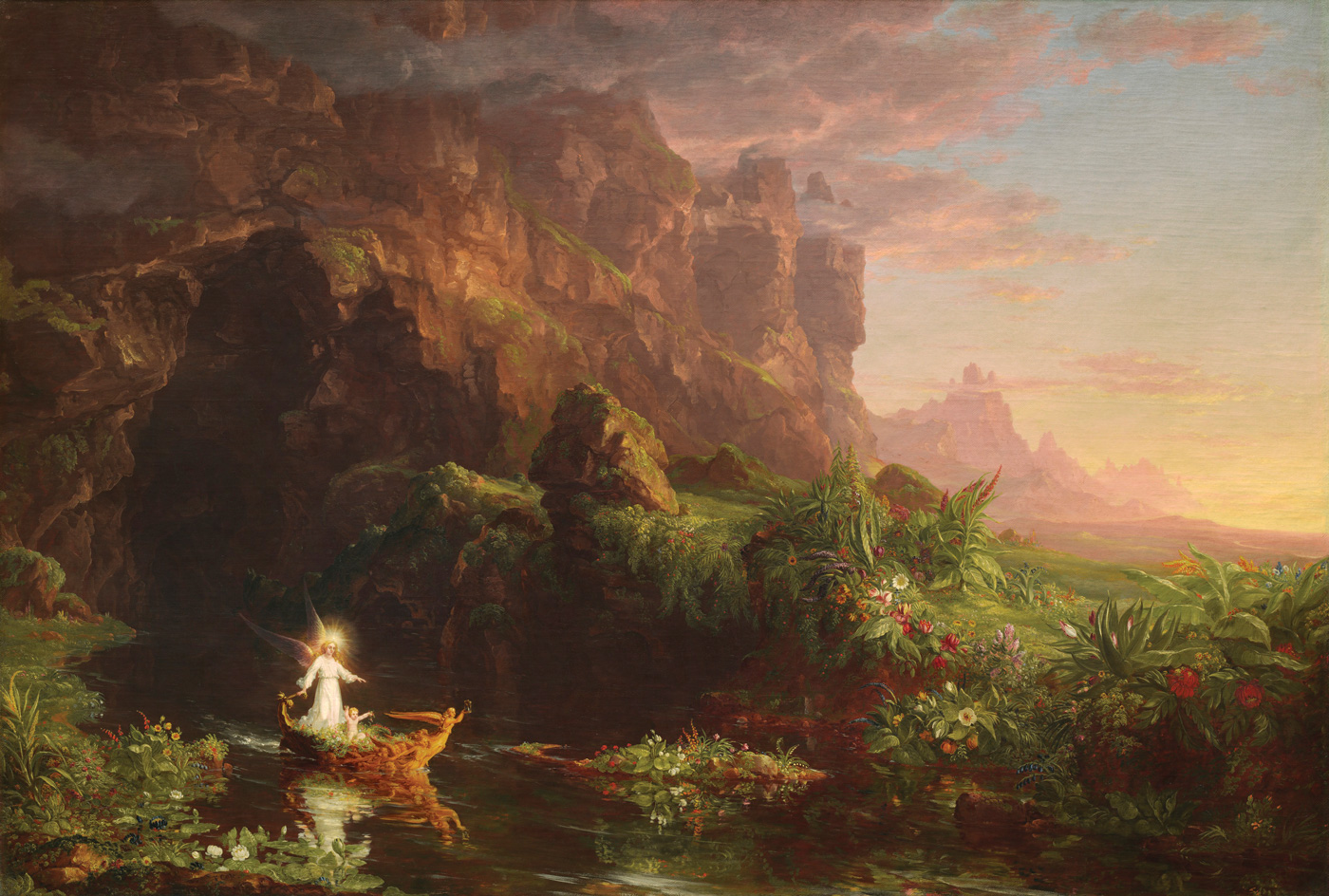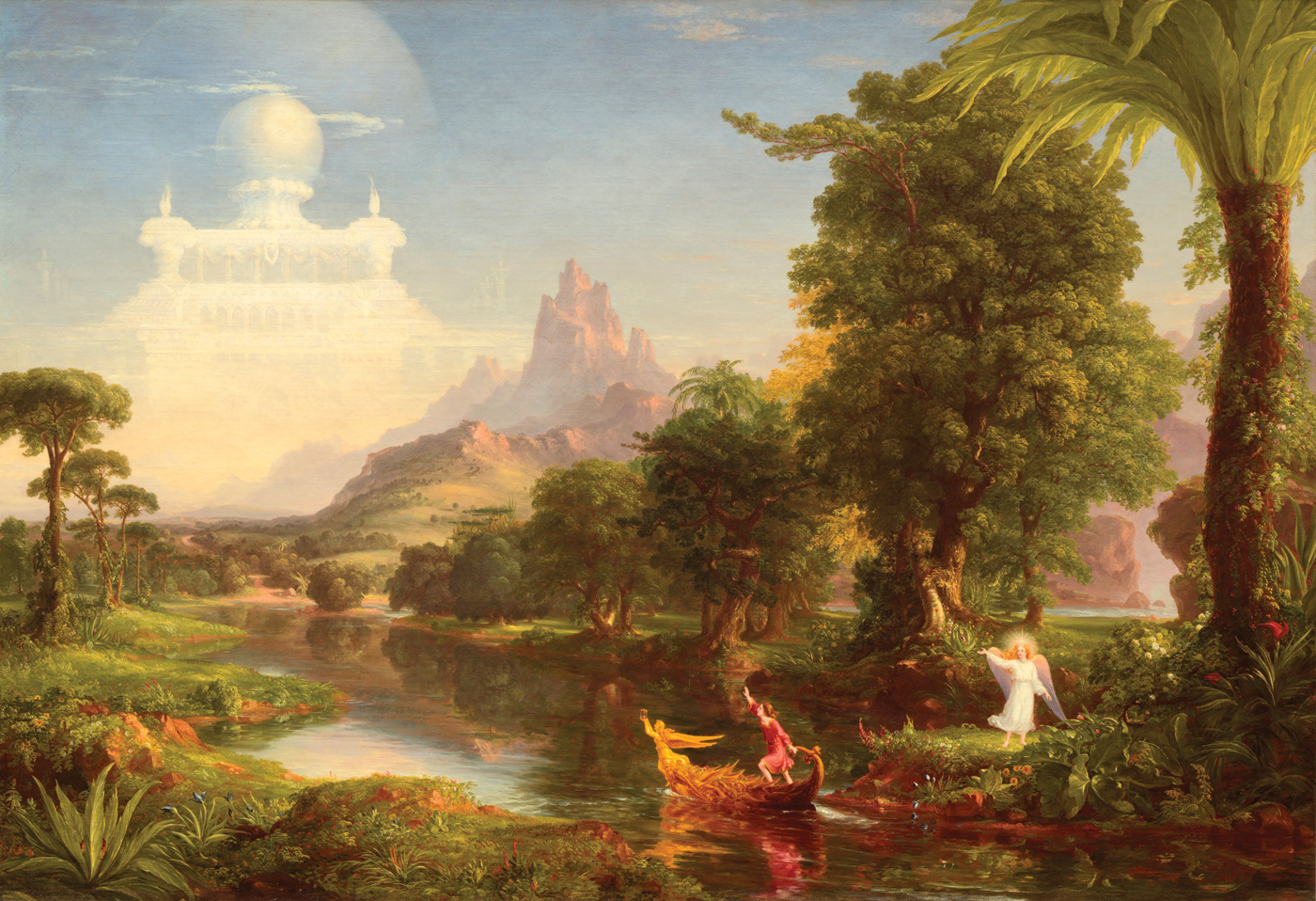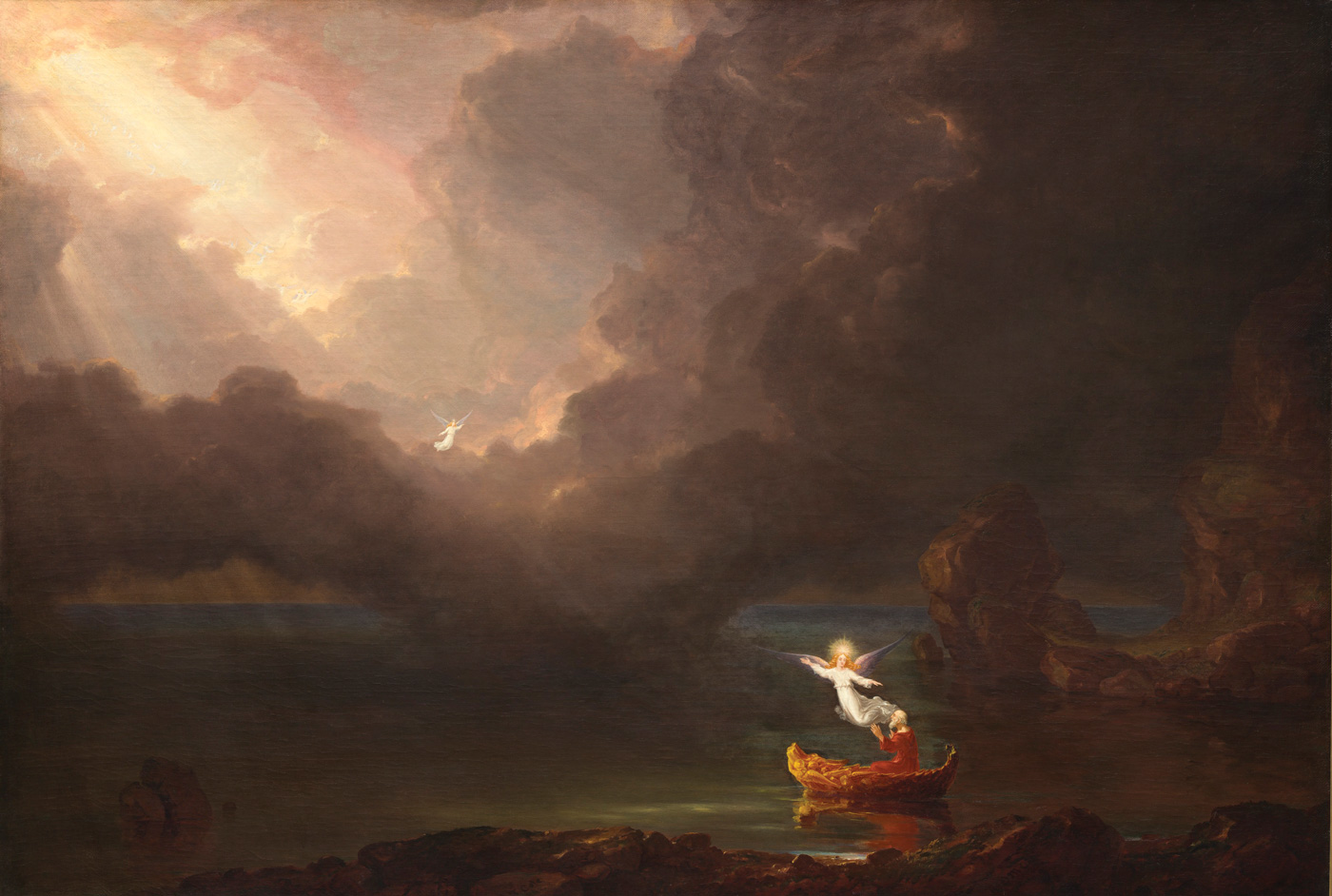33
The Voyage of Life
(paintings, 1842)
Sometimes when we stand quietly before a breathtaking natural vista we somehow feel more alive, we sense the pulse of the created world, and all the glory before us causes us to think a little more deeply about the meaning of our lives. Thomas Cole made a career of painting such visions, and he was never shy about the idea that painting could be a way of manifesting the deepest truths. His canvases are gentle sermons, rooted in his appreciation for the wonders of the natural world, which “declare the glory of God” and “proclaim the work of his hands” (Ps. 19:1).
Sometimes Cole let nature speak for itself, but at other times he wed his depictions of the natural world with allegorical ruminations about human nature and destiny, as in his four-painting series, The Voyage of Life. The Voyage of Life is an allegory for the four stages of human life, filled with both warning and promise about what lies ahead for each of us as we journey through our lives. The same elements are repeated in each of the four paintings: a voyager, an angel, a river, a boat in which the voyager travels, and the landscape, which transforms throughout the series from sublime to forbidding and then back to sublime as it points to the world beyond this one.
In the first painting of the series, Childhood, the young traveler launches out from a cave (birth) onto a placid stream. The sun is rising in the distance, and a guardian angel stands watch in the little boat. In Youth, the second painting in the series, the view of the landscape widens, as the youth holds the tiller and the angel watches from the shore. Part of growing up is learning responsibility and setting goals for life. The boat is headed down the river toward a ghostly castle that looms before the youth, representing his dreams and ambitions, which Cole referred to as “the romantic beauty of youthful imaginings.”1

The Voyage of Life: Childhood by Thomas Cole, National Gallery of Art, Washington, DC [Wikimedia Commons, CC-PD-Mark]
All is peaceful, but not for long, as the third painting, Manhood, reminds us of the troubles and travails of existence. The little boat is entering menacing rapids, which threaten to capsize the already-damaged vessel that the traveler is now trying to navigate without its tiller. There are rocks, whirlpools, and other dangers ahead, and nature itself seems arrayed against him. The landscape is dark, the skies are stormy, and the rain is falling in torrents. The angel has not forsaken him, though, still watching him from a distance, high in the sky. Ahead of him the passage is narrow and frightening, but he has no choice, he must journey on. So he folds his hands in prayer. The final painting is Old Age. Our traveler has survived the trials of life and now draws near to the end of his journey: death. The guardian angel draws close to him, and angels are descending from above as the river flows into eternity. As Cole describes this scene, “The chains of corporeal existence are falling away; and already the mind has glimpses of Immortal Life.”2
With this series, Cole shows how faith can sustain a person throughout the whole of life and into the heavenly home. Seen individually, these paintings could come across as sentimental and pious, but taken together they make a realistic statement about the struggles of life and the fact that hope is often hard-won and usually comes on the heels of hardship.
Thomas Cole was born in 1801 in England and immigrated with his family to the United States as a young man. He worked in Pennsylvania and Ohio before settling in New York State, where he spent most of his working life. Cole found early success when his paintings were admired and purchased by three prominent US artists, who later became the younger artist’s disciples. His fresh approach to the art of landscape painting, which others soon embraced as their own, gave a new dignity and importance to what had been formerly considered a minor genre for painters.

The Voyage of Life: Youth by Thomas Cole, National Gallery of Art, Washington, DC [Wikimedia Commons, CC-PD-Mark]
Cole was a poet as well as a painter, and he left behind a collection of hymn-like celebrations of beauty and the One who created it. “To walk with nature as a poet,” he wrote, “is the necessary condition of the artist.”3 One of his poems reads:
Let us give thanks to God that in His love
He grants such glimpses of the world above
That we poor pilgrims on this darkling sphere
Beyond its shadows can our hopes uprear.4
Cole was a poet with a paintbrush, and he sang the glory of God with pen and brush as he perceived it in the awesome expanses of the American wilderness.
One of his greatest early paintings is View from Mt. Holyoke: The Oxbow (1836), which shows the wilderness giving way to cultivation, and re-creates the drama of a passing storm as an artist (a tiny figure in the bottom right of the painting, probably a self-portrait) records the majestic scene. An interesting little detail are the Hebrew letters hidden in the hillside of the distant mountains. They are upside down and spell Shaddai: the Almighty. Another early work is his reimagining of the Garden of Eden (1828), which combines all sorts of flora and fauna that would normally never be seen together in one place, and its corresponding painting, Expulsion from the Garden of Eden (1828), where we see, ever so tiny, our first parents being cast out of paradise into a rocky and forbidding landscape.

The Voyage of Life: Manhood by Thomas Cole, National Gallery of Art, Washington, DC [Wikimedia Commons, CC-PD-Mark]
Cole was the founding father of a school of like-minded American landscape painters, who flourished between about 1825 and 1880, called the Hudson River School because its founders lived and painted in the Hudson River valley in upstate New York. These painters celebrated the unspoiled and undeveloped landscape of the young nation, seeing it as the “new Eden.” They were concerned about the high cost of progress and the advance of civilization, and the corrupting influence this had on the country, and were also concerned that the wilderness was slowly being destroyed to make way for humans. For them, nature was a refuge from a materialistic culture that was even then in the ascendency. Cole’s The Course of Empire (1836) is an extended meditation on how human civilizations rise and decline, but nature will eventually reassert herself. It offers a caution against the prevalent nineteenth-century belief in ever-expanding human progress—and also against materialism, commercialism, and the destruction of nature, calling viewers to a remembrance of our proper place of humility in the order of things.
Nature was not only a refuge for the Hudson River painters but also a source of illumination, revelation, consolation, and wisdom. Theirs was a spirituality founded upon the belief that God’s character was revealed in the glories of nature, and so they painted it in all its sublimity. Thomas Cole and his comrades believed that the souls of human beings could be transformed by meditating on the beauties of nature, that the beautiful and the good were closely related to each other. And so the artist is performing a spiritual act in creating art, art that can be a source of moral and spiritual transformation, and a “sweet foretaste of heaven.”5
These artists composed rather than merely recorded the glories of nature. Instead of trying to simply reproduce what they saw as it existed in nature itself, they hiked through forests and to the tops of mountains, making sketches of the beauties they saw—a majestic mountain, a tree blasted by the weather, a tumbling waterfall—and then returned to the studio to recombine the various elements into a painting that would suggest the Edenic world that existed before the intrusion of humankind.

The Voyage of Life: Old Age by Thomas Cole, National Gallery of Art, Washington, DC [Wikimedia Commons, CC-PD-Mark]
Cole and the other Hudson River painters saw natural phenomena as not only beautiful in themselves but also as symbolic of deeper spiritual truths, and they were especially interested in the effects of light and how it illuminated the scene they were creating. They saw the contemplation of beauty in nature as a way of preparing the heart and mind for the contemplation of spiritual realities, and their work as a way of manifesting the glory of God. They believed that one was called to art as one might be called to the ministry; the purpose of that vocation was to help people to see. The landscape was a grand natural cathedral, or a book that could be “read” to learn of the One who “wrote” it. “There are spots on this earth,” wrote Cole, “where the sublime and the beautiful are united—where the heart of man feels its own nothingness or rises with the most ecstatic emotions—when the lips are sealed in reverence, but the soul feels unutterably.”6
Cole feared that as nature was neglected and forgotten by his contemporaries, so would God be forgotten and neglected, for nature testified to his reality. Cole’s paintings, so often painted from a God’s-eye view of the world, showed humans to be small and insignificant in the larger scheme of things, and offered the spectacle of the wonders of the world God had made. Until his premature death at the age of forty-eight, he stayed true to his mission of depicting glimpses of God’s glory as seen in his creation, and reminders of the tragedy of human ignorance of that vision.